Battles - The Landings at Suvla Bay, 1915
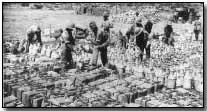 With three fresh divisions
of reinforcements promised to arrive in August 1915 by British war minister
Lord Kitchener
in London (subsequently increased to five), so Mediterranean Commander-in-Chief
Sir Ian Hamilton
began planning a major Allied offensive on the
Gallipoli peninsular
to coincide with their arrival.
With three fresh divisions
of reinforcements promised to arrive in August 1915 by British war minister
Lord Kitchener
in London (subsequently increased to five), so Mediterranean Commander-in-Chief
Sir Ian Hamilton
began planning a major Allied offensive on the
Gallipoli peninsular
to coincide with their arrival.
At this time the combined British (including Australian and New Zealand Corps - the Anzacs) and French force had established two beachheads on the peninsular: the first on the southern tip at Cape Helles, and the second further north at Ari Burnu (shortly afterwards renamed Anzac Cove).
Failed Actions at Helles
However repeated attempts to strike out north of Helles, most notably at the Battles of Krithia in April, May and June 1915, had all ended in dismal failure at heavy cost in casualties. No similar attempt to break out of the confined beachhead at Anzac had been considered however for want of reinforcements: a mere 20,000 Australians and New Zealanders were sited at Anzac Cove.
The sole major action at Anzac to date was the Allied defence against a heavy - albeit chiefly suicidal - Turkish attack launched on 19 May. Meanwhile Turkish reinforcements continued to arrive on the peninsular where attached German commander Liman von Sanders had 14 divisions at his disposal.
Plans for a New Offensive
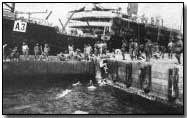 In
considering his options Hamilton opted to use his pending reinforcements to
support an Allied breakout from Anzac Cove.
In
considering his options Hamilton opted to use his pending reinforcements to
support an Allied breakout from Anzac Cove.
However the cramped beachhead itself at Anzac could not support the additional numbers of reinforcements promised by Kitchener. Thus a fresh landing site was selected further north on the Aegean coastline at Suvla Bay, with the aim of securing the Anafarta Hills.
Suvla Bay was large and ideal for the landing of a sizeable number of additional troops. Directly in front of the bay was the shallow Salt Lake, dry in August (but ill-suited for an infantry advance), and beyond that the flat Suvla plain that would serve for subsequent troop deployment.
Along with the landings at Suvla Hamilton set in train two additional attacks. He instructed the Allied force at Helles, now temporarily under the command of General Street in place of Aylmer Hunter-Weston, to strike out with a holding attack. Meanwhile the Anzacs under William Birdwood were to break out north from Anzac Cove to seize Sari Bair Ridge, aided by 25,000 fresh reinforcements smuggled into the area.
 In
planning both additional attacks Hamilton was concerned to tie up as many
Turkish troops as possible to guarantee the success of the fresh landings at
Suvla Bay.
In
planning both additional attacks Hamilton was concerned to tie up as many
Turkish troops as possible to guarantee the success of the fresh landings at
Suvla Bay.
Even so, success against Sari Bair - in conjunction with seizure of the Anafarta Hills - was crucial if the Allies were to gain complete control of the central heights of the peninsular.
From there the southern peninsular could be cut off and command of the Dardanelles Straits ensured, the Allies principal aim.
News from Berlin
On 22 July Liman received news via telegram from Berlin warning that an Allied offensive was to be expected on the peninsular in early August. In response Liman divided his 14 divisions to meet what he regarded as the most likely attack points: five were deployed at Helles, three at Anzac, three in the Bulair area and three more at Kum Kale on the Asiatic coast (where Britain's French allies had proposed a landing).
Liman did not however contemplate sending reinforcements to guard against an attack launched from Suvla Bay, where the sector remained protected by a mere three battalions comprised of around 1,500 men, the Anafarta Detachment.
Appointment of an Inexperienced British Commander
In charge of the landings was Sir Frederick Stopford, a somewhat elderly general close to retirement age whose earlier wartime service had consisted of a ceremonial posting as Lieutenant of the Tower of London. He possessed no battle experience of any description, a fact which proved crucial during the operation.
 Nevertheless
he was to guide 10th, 11th and 53rd Divisions - comprising IX Corps - during
the landings.
Nevertheless
he was to guide 10th, 11th and 53rd Divisions - comprising IX Corps - during
the landings.
Stopford, who was given his orders on the same day Liman received due warning from Berlin, was instructed that a key priority was the linking of Allied forces south once Tekke Tepe had been captured, with Birdwood's Anzac forces striking north from Anzac Cove to Sari Bair. Further, Stopford was to assist Birdwood in the capture of Sari Bair if it became necessary.
Remarkably neither Birdwood nor Helles commander Street were fully apprised of the particulars of their role in supporting the fresh landings. This merely continued am ongoing pattern of inferior communication emanating from Hamilton's GHQ. In this instance it resulted in General Street choosing to interpret his orders as enabling him to attempt a full-scale break-through attack from Helles as opposed to Hamilton's desired holding tactics.
Far more critical however was Stopford's command conduct in the aftermath of the landings. Rather than immediately strike out beyond Salt Lake as directed he chose merely to consolidate his position at Suvla Bay, in spite of the absence of Turkish opposition to hinder forward progress.
Action at Helles and Anzac Cove
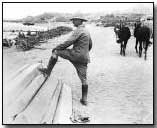 In
the event the offensive was begun on 6 August 1915 with General Street's
attack at Helles. His decision to opt for a large-scale breakthrough
attempt was immediately thrown back, and petered out entirely on 10 August,
freeing up Turkish forces for more critical activity further north.
In
the event the offensive was begun on 6 August 1915 with General Street's
attack at Helles. His decision to opt for a large-scale breakthrough
attempt was immediately thrown back, and petered out entirely on 10 August,
freeing up Turkish forces for more critical activity further north.
Meanwhile at Anzac Cove the attempt to capture Sari Bair on 6 August similarly broke down while close to success at heavy cost in casualties in the face of confusion, ongoing delay and simple troop exhaustion.
The Landings
The landings were begun at 10pm on the evening of 6 August with 20,000 troops set down at Suvla Bay ('A', 'B' and 'C' Beaches) with virtually no Turkish opposition other than from sniper fire. The remainder of the British troops were successfully landed the following morning, albeit at disparate sites along the bay owing to reconnaissance failures.
With his troops landed Stopford opted to wait until evening before pressing forward with attacks upon the hills immediately around the bay (including Hill 10), in the course of which some 1,700 casualties were incurred. Stopford's staff officers argued that attacking the Tekke Tepe ridge before consolidating their force (including all-important artillery) would leave them open to violent attack by defending Turk forces. They remained unaware of the actual weakness of Turkish military preparedness in the sector.
Turkish Reinforcements
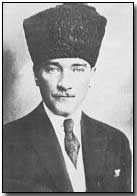 Meanwhile
Liman, having now received news of the actual landing site, despatched five
divisions to Suvla in what he regarded as an unlikely attempt to save his
Anafarta Detachment. In due course Colonel
Mustafa Kemal
was appointed by Liman to command of the sector (replacing the
under-performing Feizi Bey).
Meanwhile
Liman, having now received news of the actual landing site, despatched five
divisions to Suvla in what he regarded as an unlikely attempt to save his
Anafarta Detachment. In due course Colonel
Mustafa Kemal
was appointed by Liman to command of the sector (replacing the
under-performing Feizi Bey).
Fortunately for Liman and the Turkish army - and most unfortunately for the Allied force - Stopford, having secured the local hills, remained content that he had achieved his set aims (meanwhile directing activity from an off-shore battleship). Hamilton sent a series of unclear orders requiring Stopford to advance but it wasn't until Hamilton's personal arrival on the afternoon of 8 August that the position was made clear to Stopford. Meanwhile the freshly-arrived (and inexperienced) British troops were rested on the beach.
Hamilton promptly issued orders that the Tekke Tepe ridge to the east be rapidly secured. However by the morning of 9 August - by which time the British attack was only just gathering pace - Kemal and his Turkish force had secured the heights of the ridge and of the Anafarta Spur to the south.
Hamilton nevertheless continued to order fresh British attacks against the ridge over the course of the following three days, all of which ended in failure: while Kemal poured in reinforcements to surround the Allied beachhead at Suvla in the same manner as at Cape Helles and Anzac Cove earlier in the year.
Heavy Casualties - and Trench Warfare
Losses were predictably heavy. The Allies suffered approximately 18,000 casualties at Suvla Bay and at Anzac Cove, plus a further 3,500 at Helles. Liman's forces suffered 18,000 casualties at Anzac Cove and anything from 9,000-20,000 at Suvla Bay.
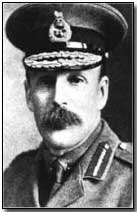 Once
again a state of trench warfare set in from Suvla. Stopford was sent
home to London in disgrace in mid-August and
Henry de Beauvoir
de Lisle appointed in his
stead.
Once
again a state of trench warfare set in from Suvla. Stopford was sent
home to London in disgrace in mid-August and
Henry de Beauvoir
de Lisle appointed in his
stead.
Somewhat belatedly Western Front commanders were drafted in to provide a level of experience at divisional level. However Frederick Maude, Julian Byng and General Fanshawe's arrival was too late to salvage the Allied position at Suvla.
Hamilton's next objective was to be the linking up of Allied forces at Suvla Bay with those sited at Anzac Cove, a distance of some 5km, and resulted in the Battles of Scimitar Hill and Hill 60.
To view maps detailing the progress of the Gallipoli campaign click here; and here; and here; and here.
Photographs courtesy of Photos of the Great War website
"Toc Emmas" was slang for trench mortars.
- Did you know?
